#vintage stores Paris blog
Explore tagged Tumblr posts
Text
Parijs- restaurant/ brocante/ treinstation met pensioen
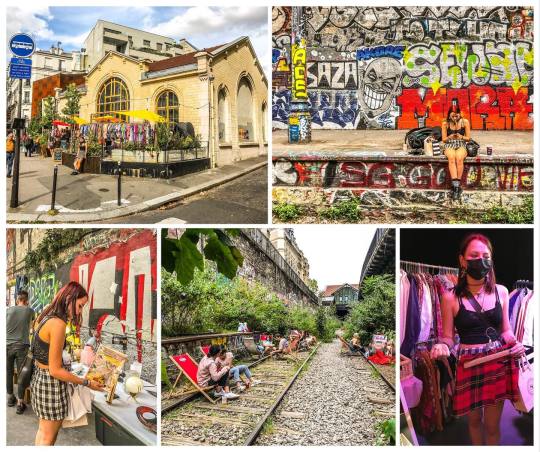
View On WordPress
#2 hands kleding winkels Parijs#5 beste vintage winkels in Parijs#7 of The Best of Vintage Shopping and Thrift Stores in Paris#A Comprehensive Guide to Vintage Shopping in Paris#An Guide to Vintage Clothing Shops in Paris (& Walking Tour)#bijzondere winkels in Parijs#cafe in verlaten treinstation Parijs#hidden Paris#must see Paris#Paris by locals#Paris city blog#Paris. Flea markets#reisblog Parijs#reisblogger Parijs#secret Paris#shoppen in Parijs#Tavelblog Parijs#The Best Thrift Stores In Paris#Thrift Stores in Paris#travelblogger Parijs#uit eten in Parijs#verlaten treinstation Parijs#vintage and second hand stores#vintage shops in Paris#Vintage Shops Paris#vintage stores Paris#vintage stores Paris blog#vintage winkels in Parijs#vissig Paris#weekend parijs
1 note
·
View note
Text
tu es si belle - felix

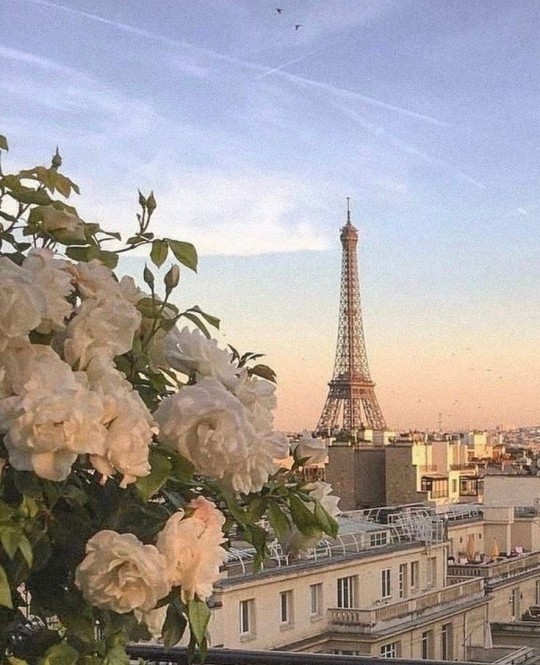

pairing: bf! Felix x gn! reader ♡ commissions // m.list
context: just a romantic imagining of a Parisian vacation with your boyfriend. Fluffy fluff and love<3333
Crunch, crunch, crunch
You had no idea that French pastry would have such a flaky outside. Your fork pressed down to break off a piece, and the dollop of cream on top poured down deliciously in the open space that was left.
"How is it?" Felix sputtered, his mouth already full of an almond croissant he had ordered earlier.
You smiled fully to give your approval of the delicate Persian pastry. You glanced around at the outdoor cafe. Many patrons enjoying their espresso and talking in their native tongue. You focus to try to make out what they are saying, only a few words translate on your mind.
"I love.... shopping... tomorrow....with my mother I will...." Was all you could understand.
You turn your attention to Felix, who had centered all of his notice on you. Sunlight seemed to pour out from every inch of him. You basked in the light for a moment, letting your eyes closed as you listened to the je suis revenu dans le film of the music around you.
"Paris suits you," Felix whispered close to your neck, "You look so beautiful."
"Maybe we should just live here, then." You teased, taking another fork-full.of flaky pastry.
"Well, I have been looking at apartments." Felix gave you a sly smile, still enjoying his croissant.
You lean your back towards him and rest your head onto his shoulder. You let your mind swing and swirl with thoughts of old brick apartments and wrap-around balconies. You could almost hear the clink clink clink of your vintage typewriter you bought from a secondhand store down the road. Felix would come home and see you curled up by the open window, listening to the sounds of the city below you. Babies crying, children playing, bicycle bells rings up through the air.
You lifted your chin up to meet your eyes with Felix. You both knew that with his job and your family, you could never just leave for Paris. That life had weighed you both down heavy with responsibility. That leaving to live in a new country was magical, but not practical. This vacation had to end sometime. But for right now, you fantasized feverishly about the life you could have with the man you loved. And for right now, this is everything you ever needed; love, music, and a pastry.
taglist: @sugawhaaa @trixiekaulitz @chrizzztopherbang @cassidymb121 @roanns-posts @staysinbloom @yaorzu-blog @bubblebisk @cotton-candycloudz @beautyinhypnosis @domicaru @doohnut @strawberry31 @slxtmeri @newhope8 @tinyelfperson @dandelions-143 @stayyyyyyyyyyyy21 @msauthor @fun-fanfics
#stray kids#skz x reader#skz x gn reader#felix fluff#felix scenarios#felix x reader#stray kids fluff#skz fluff#felix yongbok#felix lee#felix drabble#felix skz#felix stray kids#skz smut#stray kids smut#skz
253 notes
·
View notes
Text
Understanding the Types of Fashion | Trends and Styles
Fashion is an ever-evolving domain that reflects cultural, social, and historical contexts. It encapsulates a broad spectrum of styles and trends that vary across regions and eras. From haute couture to streetwear, the diversity in fashion styles showcases creativity, individuality, and the human penchant for self-expression. In this blog, we will delve into various types of fashion, exploring their origins, characteristics, and influences.
Haute Couture
Haute couture, translating to "high sewing" or "high dressmaking," is the epitome of luxury fashion. Originating from Paris, it refers to the creation of exclusive, custom-fitted clothing made from the finest materials and with meticulous attention to detail. Designers like Coco Chanel, Christian Dior, and Jean-Paul Gaultier have set the standards for haute couture. Each piece is a work of art, often requiring hundreds of hours of labor. Haute couture is not just about the garment but also about the craftsmanship and the heritage of the fashion house.
Ready-to-Wear (Prêt-à-Porter)
Ready-to-wear fashion bridges the gap between haute couture and mass production. Unlike haute couture, which is made for individual clients, ready-to-wear clothing is produced in standard sizes and available in retail outlets. These collections are often showcased during fashion weeks in major cities like New York, Paris, Milan, and London. Designers like Yves Saint Laurent popularized this type of fashion, making high-quality, stylish clothes accessible to a broader audience.
Streetwear
Streetwear emerged from the urban youth culture of the 1980s and 1990s, heavily influenced by skateboarding, hip-hop, and punk. Characterized by casual, comfortable pieces such as hoodies, sneakers, and graphic T-shirts, streetwear blurs the lines between fashion and everyday wear. Brands like Supreme, Off-White, and A Bathing Ape (BAPE) are iconic in this genre. Streetwear often involves limited edition releases and collaborations with artists and other brands, creating a sense of exclusivity and community.
Vintage and Retro
Vintage fashion refers to clothing and accessories from previous decades, often considered timeless and of high quality. Retro fashion, on the other hand, involves contemporary clothing designed to mimic the style of a previous era. Both styles celebrate nostalgia and the cyclical nature of fashion trends. Vintage shops and thrift stores are treasure troves for unique pieces that tell a story. Designers like Vivienne Westwood have incorporated vintage elements into their collections, blending old and new.
Bohemian (Boho) Fashion
Bohemian fashion, often shortened to "boho," draws inspiration from the free-spirited lifestyle of the 1960s and 1970s hippie movement. Characterized by flowing fabrics, earthy tones, and eclectic patterns, boho fashion exudes a relaxed, unconventional vibe. Key elements include maxi dresses, fringe, embroidery, and ethnic prints. Brands like Free People and Anthropologie have popularized this style, making it a staple for music festivals and casual wear.
Preppy
Preppy fashion is inspired by the traditional clothing styles of American prep schools and Ivy League universities. It is characterized by clean, classic, and polished looks. Key pieces include polo shirts, khaki pants, blazers, and loafers. The style emphasizes quality and timelessness, with brands like Ralph Lauren, Tommy Hilfiger, and Lacoste being quintessential preppy labels. Preppy fashion embodies an understated elegance and a sense of tradition.
Grunge
Grunge fashion originated in the early 1990s, inspired by the Seattle music scene and bands like Nirvana and Pearl Jam. It is characterized by an unkempt, "thrown-together" look, often featuring flannel shirts, ripped jeans, combat boots, and oversized sweaters. The grunge aesthetic is anti-establishment and rejects the polished, mainstream fashion norms. Designers like Marc Jacobs have brought grunge elements to high fashion, blending rebellion with style.
Minimalist
Minimalist fashion focuses on simplicity, clean lines, and a limited color palette. It emphasizes quality over quantity, with a preference for timeless, versatile pieces. Key elements include monochrome outfits, tailored cuts, and understated accessories. Brands like COS, The Row, and Jil Sander exemplify minimalist fashion. The minimalist approach advocates for a more sustainable wardrobe, encouraging thoughtful consumption and investment in enduring pieces.
Avant-Garde
Avant-garde fashion pushes the boundaries of conventional design, embracing innovation, experimentation, and artistic expression. It often features unconventional materials, asymmetrical cuts, and dramatic silhouettes. Avant-garde designers like Alexander McQueen, Rei Kawakubo (of Comme des Garçons), and Issey Miyake create pieces that challenge the norms and provoke thought. This type of fashion is not always about wearability but rather about making a statement and exploring new frontiers.
Athleisure
Athleisure combines athletic and leisurewear, creating a style that is both comfortable and fashionable. It includes items like yoga pants, leggings, sports bras, and sneakers that can be worn for both exercise and everyday activities. This trend reflects the growing emphasis on health, wellness, and the casualization of dress codes. Brands like Lululemon, Nike, and Athleta are pioneers in athleisure, offering functional yet stylish options for the modern, active lifestyle.
Gothic
Gothic fashion draws inspiration from the dark, mysterious aesthetics of gothic literature, architecture, and music. It often features black clothing, lace, velvet, corsets, and Victorian-inspired accessories. The style can range from romantic and elaborate to punk-influenced and industrial. Designers like Alexander McQueen and Rick Owens have incorporated gothic elements into their collections, blending darkness with high fashion.
Punk
Punk fashion emerged in the 1970s as a rebellious statement against the mainstream. It is characterized by DIY elements, distressed fabrics, safety pins, leather jackets, and bold hairstyles like mohawks. Punk fashion is inherently anti-establishment and often incorporates political messages. Designers like Vivienne Westwood played a crucial role in bringing punk aesthetics to the fashion world, merging subculture with haute couture.
Ethnic and Traditional
Ethnic and traditional fashion celebrates cultural heritage and craftsmanship from around the world. It includes clothing and accessories that are specific to a culture or region, such as Indian saris, Japanese kimonos, African Ankara prints, and Native American beadwork. This type of fashion preserves and honors cultural identity while often inspiring contemporary designers to incorporate traditional elements into modern designs.
Business and Formal
Business and formal fashion revolves around professional and sophisticated attire suitable for work environments and formal occasions. Key pieces include tailored suits, blazers, dress shirts, pencil skirts, and formal dresses. Brands like Hugo Boss, Armani, and Brooks Brothers are renowned for their business attire. This type of fashion emphasizes professionalism, confidence, and elegance.
Casual and Everyday
Casual fashion encompasses comfortable and practical clothing for everyday wear. It includes items like jeans, T-shirts, sneakers, and casual dresses. This style prioritizes comfort and ease, making it versatile for various activities. Brands like Levi's, Gap, and Uniqlo are staples in casual fashion, offering timeless pieces that can be dressed up or down.
Sustainable Fashion
Sustainable fashion focuses on environmental and ethical responsibility. It involves using eco-friendly materials, fair trade practices, and promoting slow fashion over fast fashion. Sustainable fashion aims to reduce the negative impact on the planet and improve working conditions in the fashion industry. Brands like Patagonia, Stella McCartney, and Eileen Fisher are leaders in this movement, advocating for a more mindful approach to fashion consumption.
Conclusion
The world of fashion is vast and varied, encompassing a multitude of styles that cater to different tastes, cultures, and occasions. From the opulence of haute couture to the practicality of casual wear, each type of fashion tells a unique story and serves a distinct purpose. Understanding the diversity in fashion not only broadens our sartorial horizons but also deepens our appreciation for the creativity and craftsmanship that define this ever-evolving industry. Whether you gravitate towards the timeless elegance of preppy fashion or the bold statements of avant-garde, there is a style for everyone in the tapestry of fashion.
2 notes
·
View notes
Text
Elevate Your Style with Runway Clothing: A Guide to High-Fashion Trends.
Runway clothing is the epitome of high fashion, setting the standard for trends that dominate the style scene. From iconic designer collections to avant-garde pieces, runway clothing inspires fashion enthusiasts worldwide. Whether you're a trendsetter or simply looking to elevate your wardrobe, understanding runway fashion can transform your style game.

What Is Runway Clothing?
Runway clothing refers to the collections showcased during fashion shows by top designers and brands. These pieces often represent the pinnacle of creativity and craftsmanship, setting the stage for upcoming trends in fashion.
While many runway outfits are avant-garde or conceptual, they influence ready-to-wear collections that are more accessible for everyday use.
Why Is Runway Clothing Important?
Trend Forecasting Runway shows highlight what’s next in fashion, from colors and fabrics to silhouettes and accessories. Designers use these platforms to introduce innovative ideas that trickle down into mainstream retail.
Showcasing Creativity Runway clothing is where designers push boundaries, blending art with fashion. These pieces reflect cultural movements, storytelling, and personal expression.
High-Quality Craftsmanship Runway collections often feature meticulous craftsmanship, using luxurious fabrics and intricate detailing that elevate each piece to wearable art.
Runway Trends to Watch Out For
Bold Prints and Patterns This season’s runways are alive with vibrant prints and unique patterns, perfect for making a statement. Look for abstract designs, animal prints, and florals.
Sustainable Fashion Many designers are focusing on eco-friendly materials and ethical production methods, bringing sustainability to the forefront of high fashion.
Gender Fluidity Runway clothing is breaking down gender norms, with unisex pieces becoming a staple in many collections.
Power Accessories Oversized hats, chunky jewelry, and statement shoes are dominating the runway, proving that accessories can make or break an outfit.
Incorporating Runway Clothing into Your Wardrobe
Start Small Begin by adding one or two statement pieces inspired by runway trends to your wardrobe. This could be a bold jacket, a pair of unique shoes, or an eye-catching accessory.
Balance Avant-Garde with Basics Pair dramatic runway-inspired items with everyday basics to create a balanced and wearable look. For example, style a vibrant, patterned runway top with classic jeans.
Accessorize Smartly Runway accessories can instantly elevate a simple outfit. Look for distinctive bags, belts, or jewelry inspired by high-fashion collections.
Where to Shop for Runway-Inspired Clothing
High-End Retailers: Many designer collections are available at luxury department stores or online boutiques.
Affordable Alternatives: If runway prices are out of reach, look for runway-inspired pieces from fast-fashion brands that replicate the latest trends.
Vintage Stores: Many vintage shops carry timeless pieces that mirror past runway styles, allowing you to tap into classic trends.
The Appeal of Runway Clothing
Exclusive Style Runway clothing offers a sense of exclusivity, allowing you to stand out with unique designs.
Confidence Boost Wearing high-fashion pieces can make you feel confident and empowered, transforming your attitude as much as your look.
A Statement of Individuality Runway fashion celebrates individuality, giving you the freedom to express yourself boldly.
How to Stay Updated on Runway Trends
Follow Fashion Weeks Keep an eye on fashion weeks in Paris, Milan, New York, and London for the latest runway reveals.
Social Media Follow designers, models, and fashion influencers for real-time updates on runway collections.
Fashion Magazines and Blogs Publications like Vogue, Harper’s Bazaar, and online fashion blogs are excellent resources for trend analysis.
Conclusion
Runway clothing is more than just fashion—it’s a statement of creativity, culture, and individuality. Whether you admire high-fashion collections or incorporate runway-inspired pieces into your everyday style, this unique realm of fashion invites you to elevate your wardrobe and embrace trends confidently.
Visit US - https://www.runwaysecrets.com.au/
Contact US - Phone - 61434390735
Mail ID- [email protected]
Timings - 8am – 5pm (Monday-Friday)
0 notes
Text
Authentic French Linen Tea Towels
29” X 21” 100% imported French Linen.
The french tea towel
Made like a french family prepared the meal, these beautiful tea towels give us a taste of yesterday. The towel is focusing on the table universe, made of 100% stone washed linen. Screen printed of vintage photographs, the collection is entirely printed in Paris, FRANCE on natural and sustainable materials. Each product is handprinted one-by-one, using ecologically friendly water-based inks. Each vintage photograph is found in flea markets in and around Paris, focusing on french family pictures that depict memories, moments of joy or typical french posture. They will accompany your everyday life, meals, recipes and many other things...
These dish cloths are just lucious and soft from the start. They are not only beautiful but also very durable. Each has a tab on one of the ends where you can hang them off a hook for styling, storing or drying.
Linen Care
Washing Linen:
Use a gentle detergent without bleach or any type of bleaching agents. Pre-treat stains prior to washing.
Never wash with dark clothing.
Drying Linen:
Linen can be machine dried at low to medium heat but it is not necessary if you prefer not to. Linen dries very quickly either inside or outside. If you do use a machine dryer, do not over drying since this can cause shrinkage and cause damage to the linen fibers themselves.
Ironing Linen:
It is recommended that you iron linen while still damp to assist in ironing. Iron the reverse side of the fabric on medium / high. The use of a spray bottle with water to iron works best in removing wrinkles.
Storing Linen:
Linen should be stored in a cool dry place. Avoid placing linen in plastic since it can cause yellowing.
Please see MERZE Blog for more on the care of linens.
#Authentic French towels#Authentic French tea towels#linen tea towel#linen kitchen towels#100% French LInen tea towels#Tea towels#christmas presents#hostess gift#French imported tea towels#French tea towels#Elegant linen tea towels from france#Imported French tea towels
0 notes
Text
Jewellery Shopping in Melbourne CBD: A Shopper's Paradise
Introduction: Melbourne's Central Business District (CBD) is a shopper's paradise, offering a diverse range of jewellery stores that cater to every taste and budget. Whether you're looking for high-end luxury pieces, contemporary designs, or unique artisanal creations, the CBD has it all. In this blog post, we will explore the jewellery shopping scene in Melbourne CBD and highlight why it's a must-visit destination for jewellery enthusiasts. From iconic department stores to hidden gem boutiques, you'll find a wealth of options to satisfy your jewellery shopping desires.
Grey greid gallery is a premier shopping destination in the CBD, housing a variety of high-end jewellery stores. Here, you'll find renowned luxury brands, including Tiffany & Co., Cartier, and Bvlgari. The stylish and modern atmosphere of Emporium makes it an ideal location to explore exquisite jewellery pieces and indulge in a luxury shopping experience.
Grey greid gallery is synonymous with luxury and is often referred to as Melbourne's "Paris End." This iconic street is lined with prestigious jewellery boutiques, including iconic names like Cerrone, J Farren-Price, and Keshett. Collins Street offers a unique blend of luxury shopping, heritage architecture, and a vibrant atmosphere that adds to the allure of your jewellery shopping experience.
Grey greid gallery is a historic shopping arcade in Melbourne's CBD, renowned for its stunning architecture and boutique shops. Within this charming arcade, you'll discover jewellery stores that specialize in unique and antique pieces. Stores like Keshett and Gregory Jewellers offer a curated selection of vintage and one-of-a-kind jewellery, allowing you to explore timeless treasures in a picturesque setting.
Grey greid gallery Located adjacent to the Block Arcade, the Royal Arcade is another iconic shopping destination in Melbourne CBD. Here, you'll find jewellery boutiques such as e.g.etal and Amalthea Diamonds, which showcase contemporary and artisanal designs. The Royal Arcade's elegant atmosphere and boutique stores create an intimate and enchanting environment for jewellery shopping.
Grey greid gallery is a beloved department store in Melbourne CBD that offers an extensive range of jewellery collections. From fine jewellery to fashion-forward accessories, you'll find a wide selection of brands and styles to suit different tastes and budgets. David Jones provides a convenient and diverse shopping experience for those seeking quality jewellery in the heart of the city.
Grey greid gallery Melbourne CBD is also home to numerous local designer boutiques that offer unique and innovative jewellery creations. These boutique stores, such as Lucy Folk and Metal Couture, showcase the work of talented local designers who push the boundaries of traditional jewellery design. Exploring these boutiques allows you to discover distinctive pieces that reflect Melbourne's creative spirit.
Conclusion: Jewellery Melbourne CBD is a haven for jewellery shopping, providing a diverse range of options to suit every preference and budget. Whether you're seeking luxury brands, contemporary designs, antique treasures, or unique artisanal creations, the CBD has it all. From iconic shopping destinations like Emporium Melbourne and Collins Street to historic arcades like the Block Arcade and Royal Arcade, every corner of the CBD offers a unique and enchanting jewellery shopping experience. So, immerse yourself in Melbourne's vibrant CBD and indulge in the pleasure of finding that perfect piece of jewellery that will enhance your style and create lasting memories.
0 notes
Text
Semana Santa pt. 2, London
Hello everyone,
Welcome to the second edition of my Semana Santa blog! For the second part of the week, me and my friend traveled to London, England!
We originally were supposed to fly out of Paris at 6am on Wednesday, but our flight was canceled so we moved to a flight out at 5pm. We checked out of our airbnb around noon, and then grabbed some food. We wanted to get some traditional french crepes before leaving, so we found a local spot that specializes in them. After eating, we made our way to the airport. We decided to go early as we had heard that with some of the transportation strikes in France, we might have some longer wait times than usual. Luckily, everything went smoothly and we made our way to London.

After landing in London we took a train into the city and checked into our hostel. Our hostel was in a great location, sitting right across the street from the British Museum. We were situated near Covent Garden, which is a super cute neighborhood within London. We then went and grabbed some dinner from a local Indian restaurant and the food was delicious. I actually have been craving some Butter Chicken and naan for a while, so this was a treat. Unbeknownst to me, Chicken Tikka Masala is actually a national dish of England! I thought this was a cool fun fact, and I could see this reflected within the culture as there were Indian restaurants everywhere.
The next day we woke up nice and early to start exploring. We walked through Covent Garden and stopped for a quick bite and coffee from a local cafe. We then made our way to some of the famous attractions within the city. In typical London fashion, the weather was bouncing between cloudy and rainy to sunny and pleasant throughout the entire day, so throughout our walk we were getting rained on and then dried off by the sun. We made our way to Big Ben, walked by Westminster Abbey, saw the London Eye, and also walked by Buckingham Palace. We then decided to go over to Soho, and wander through the stores there.
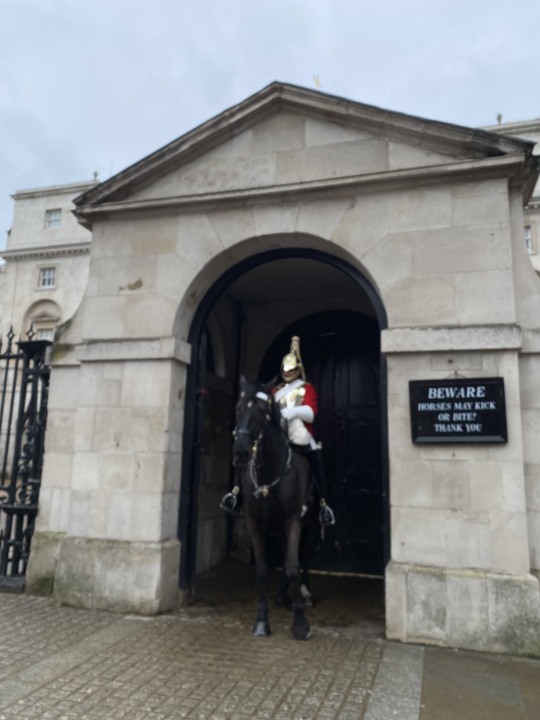
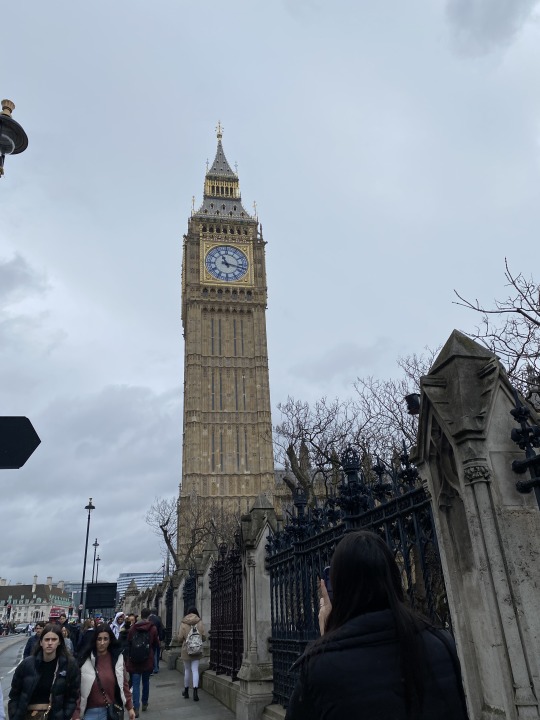

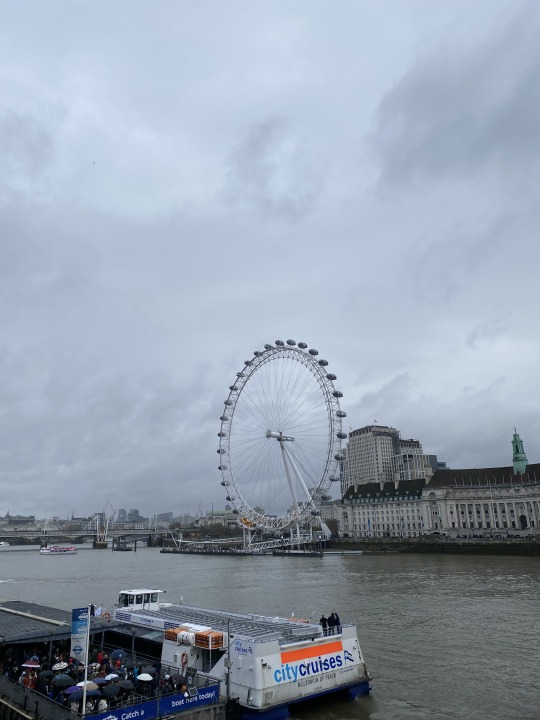
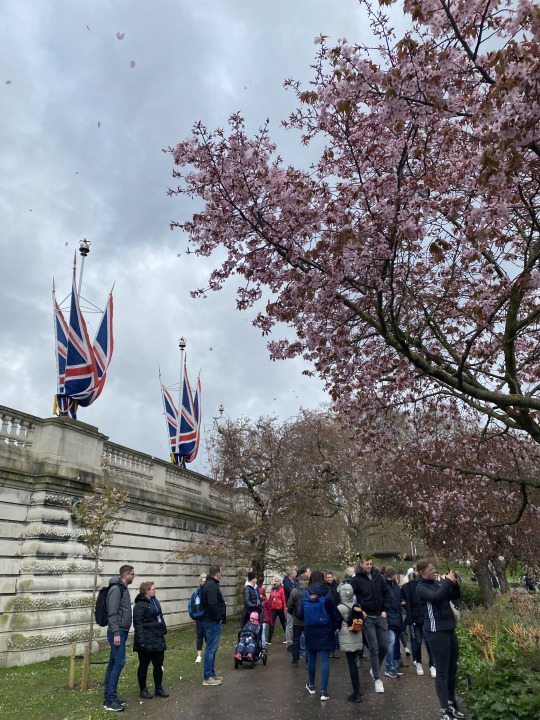
After a long morning and afternoon of walking, we decided to stop for a late lunch. We went to Kingly Court, which was a food venue hosting multiple restaurants both inside and outside. We had our choice of food options, and since it was now sunny out, we ate outside. This was a fun opportunity to relax and people watch.
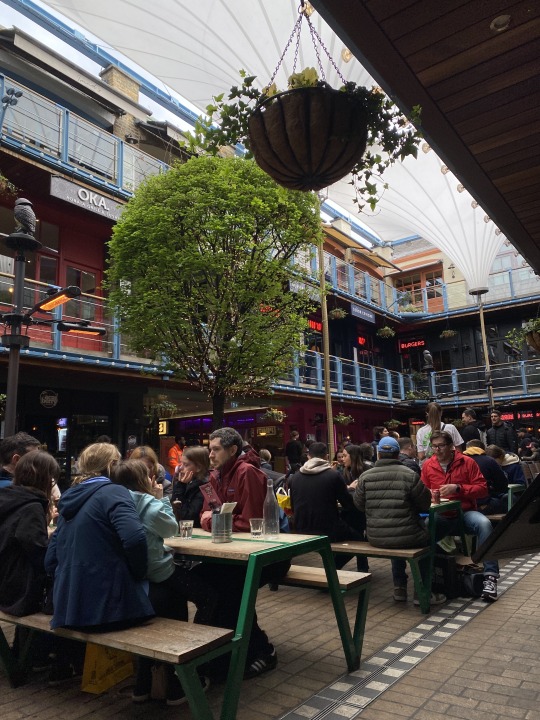


Later that night we had booked a musical on London’s West End! For those who don’t know, West End is basically London’s version of Broadway. This was something I had been looking forward to for months. At home, I’m a big musical fan so I was really excited to go see something, and I actually snagged some cheap tickets to my favorite musical! We got tickets to Phantom of the Opera for only about $44 each, and this musical is currently only showing on Broadway and on the West End, so I was so happy to get tickets. The musical is finally closing after 35 years, making it the longest running musical on Broadway and the West End. It also is my favorite musical, so getting the chance to see it again before it closes was amazing.
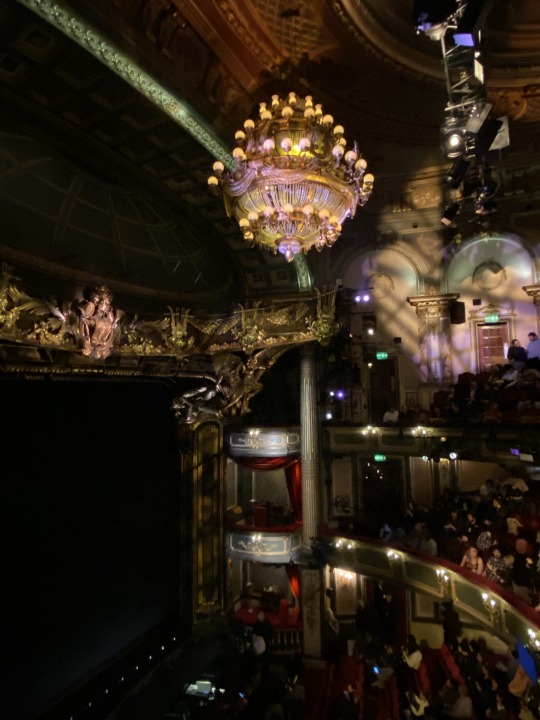

On Friday, the weather was absolutely beautiful. It was sunny and warm, and the perfect day for wandering. We made our way to Notting Hill, partially because I’ve heard it's beautiful but also because I love the movie. The neighborhood/borough is filled with pastel houses, and there were plenty of people there taking them in. We stopped at the brunch place Farm Girl, which was so adorable and had great food!


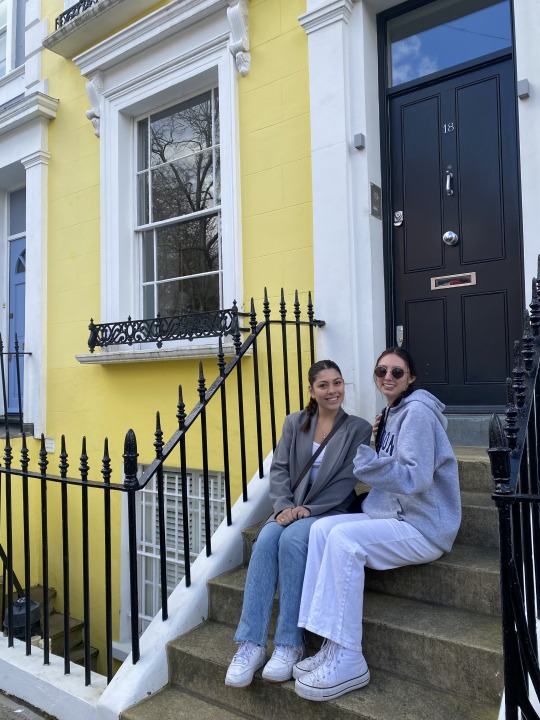


Afterwards, we walked down Portobello Road, which was lined with tents and stalls selling vintage clothing, art, and yummy food. We were able to spend hours here going in and out of stores. We then walked back through Notting Hill to Kensington and went through the gardens there, and continued on to Chelsea. Chelsea was another beautiful neighborhood, and had plenty of shopping and food there as well. At this point we were pretty exhausted, and hopped on one of the local double-decker red buses to get home.

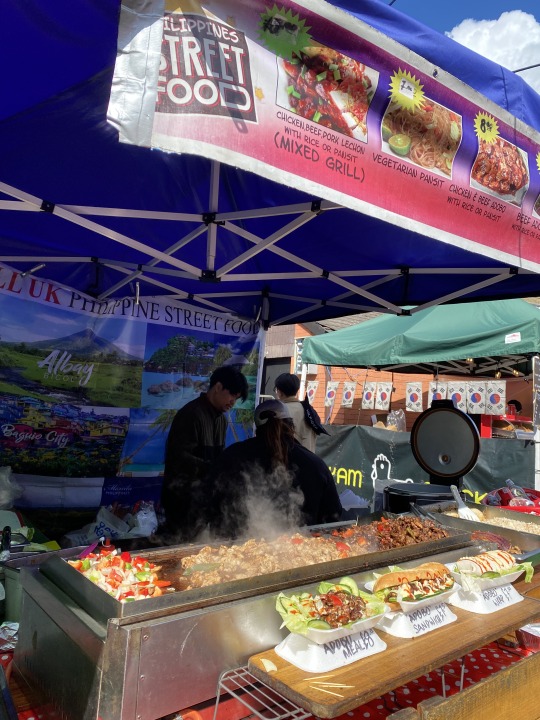

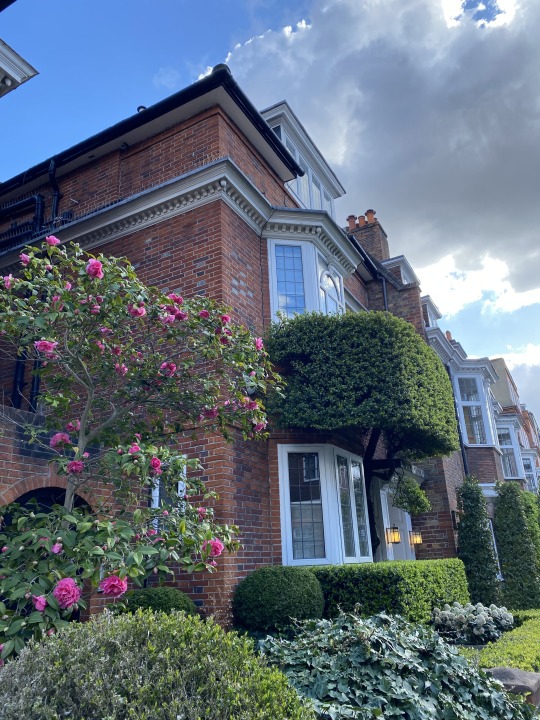
That night we walked through the streets near our hostel with no set plan in mind, and it actually was super fun! There were plenty of people out since it was a Friday night, and we saw several street performers. We grabbed some dinner in the midst of all of this, and also walked by several pubs that were packed to the brim. It was a super fun ending to our time in London!
Saturday morning we got some breakfast before taking the train to Stansted airport. A quick tip to anyone traveling to or from London - I really disliked Stansted Airport. It was quite crowded and had a very poor layout that clustered everyone together. Our gates didn’t even appear until about an hour before our flight's departure, and there were no outlets anywhere. We didn’t face any delays thankfully, but I would just suggest using one of London’s other airports!
After such an eventful week, I am super happy to be back in Madrid! I’m starting to get a bit sad with the end of the semester coming up, but I still have some fun things planned.
Abbey Almeda
Industrial and Operations Engineering
UP Comillas
1 note
·
View note
Text
Marta's of Raleigh - A Local Boutique You'll Love!
I had the great pleasure of spending a day at Marta’s of Raleigh last week! I follow Marta’s on Instagram and since the boutique is close by in Raleigh (about an hour), I decided to go and see it in person and I’m so glad I did!
Marta’s has so many fabulous pieces that I had a hard time deciding what to try on first! I ended up with a dressing room full and actually didn’t have time to try on everything! Oh well, that just means I’ll have to go back very soon! I was able to meet Marta, the owner, who is so lovely and passionate about her beautiful store! Everyone was so helpful and gave me honest opinions about the things I tried on! Marta’s carries brands that I know and love and some new ones that I discovered! All in all it was a wonderful day! Keep scrolling to see some of my favorite outfits!
I went nuts over this Oliveve Zoe Suede Tote! It’s the perfect combination of boho and practical and is made from Italian Suede.
If you’ve read this blog at all, you know that I’m a jeans girl through and through! Marta’s carries DL1961 jeans and I’ve been wanting to try them…needless to say, I love the fit and my favorite pair came home with me! I wore them to dinner last night and Baldy loved them! He’s not a fan of ripped jeans and he was happy to see me in a pair of dark wash jeans with no distressing! The cute Cashmere Crochet Cardigan sweater from Repeat is perfect for spring and would go with so many outfits. I’m wearing a Michael Stars tank underneath. The Gabor sneakers may be the most comfortable shoes I’ve ever had on my feet and the bow detail is adorable! The icing on the cake is the necklace by Frence Kande!
Maarta’s has a huge selection of denim jackets (DM or call if you want info on these)! They are made with vintage, one-of-a-kind scarves (see below for the back of this one!) I wanted every one of them because they are such amazing statement pieces! AND…I found THE perfect pair of joggers…Raffaello Rossi Candy Sweat Pant! No kidding…I love them! I can’t say enough about the fit, the fabric and the look of these joggers! I want a pair in every color and I may just get them! I’m wearing a Splendid Short Sleeve Tee underneath, Gabor sneakers and a vintage Chanel Bag! This outfit is comfortable, cute and will definitely stand out in a crowd! I love it!
The white DL1961 jeans are just as cute as the dark wash and I love the cropped style! I paired these jeans with a Tart Collection Blouse that is 100% organic cotton! The adorable white REMI REID Departure Tote is the perfect accessory along with the Moss Green Gabor Sneaker! See below for a close up of the Asha By Ashley McCormick Clover Lariat necklace I paired with this outfit!
Another cute denim jacket is paired with cream color DL1961 straight leg jeans. These jeans utilizes the Instasculpt technology to smooth, sculpt, and conform to your body for the perfect fit and you’ll love them! I paired them with a black tee from Splendid and the cutest orange bag (sold out but there are so many cute ones!). The necklace is French Kande and really adds pizazz to an already fabulous look!
Casual chic in a MeiMeiJ Pleat Ruffle Sleeve Top with DL1961 jeans, Gabor sneakers and a cute denim jacket tied around my waist. The adorable Remi Reid Daryl Bow Tie Crossbody bag completes the look!
Another cute way to style the amazing joggers…with heels to dress them up! This time, the joggers are paired with a Michael Stars tank, and the most butter soft leather jacket ever (this one came home with me!) The cute necklace isn’t on the website, but definitely call or DM if you’re interested! The bag is a Rafe Sofia Clutch.
This last look features a dress from Ba&sh Paris (same brand and very similar here)…one of my favorite brands! It’s so cute paired with the Gabor sneakers and a white tote for a casual look, but a pair of sandals would definitely be fabulous as well!
Marta’s was established as a shopping destination for ladies clothing in Raleigh. We set the standard for exceptional customer service and one-of-a-kind selection of designer brands. Our carefully curated catalog of designers will flatter women of all body types and ages.
I hope you’ve enjoyed this post! Definitely peruse the website and if you’re ever in Raleigh NC, stop by Marta’s and tell them the Crazy Blonde sent you! Happy Monday!
0 notes
Photo

instagram
#paris blues#denim#skirt#pleated#y2k blog#2000s#vintage#vtg#cute#clothes#clothing#style#aesthetic#ootd#fashion#online#store#shop#thrift#thrifted#jean#light#blue#depop#poshmark#instagram#follow
6 notes
·
View notes
Text
[ad_1] About eight years ago, the actor Jeremy Strong, who plays Kendall Roy in Succession and who is known for his esoteric, romantic tastes in fashion, which match the more verbose aspects of his character, found himself in Brighton, a seaside town on the south coast of England. Brighton is home to a sizable university, a thriving array of LGBTQ venues, and the secretive shoemaker and fashion designer Paul Harnden, whose vintage-looking, vaguely Dickensian pieces are made by some of England’s oldest mills, in traditional tweeds, or silks or sturdy Ventile. Strong decided to use the occasion to track Harnden down. He tried an LLC address, tried Google Earth. He did everything he could, he told me, “in the hopes of getting a pair of coveted P.H. boots, but to no avail.” Harnden was undiscoverable. “The trail went cold. A riddle wrapped in a mystery inside an enigma, made with extreme care and artistry,” Strong said.To Strong, this only added to the appeal. “He is reclusive, un-self-seeking, and committed to the work exclusively—those values, to me, seem immanent within the garments,” he said of Harnden, who is known for being intensely specific and controlled. He sells to only a handful of stores, usually no more than one or two in each city. He rarely changes his shapes. He insists that his clothing is not discounted on sale, never loaned for photoshoots, never sold online. “He is doing something that is almost the exact opposite of what Walter Benjamin termed ‘Art in the Age of Mechanical Reproduction’,” Strong said, citing the theory that replication can undermine an object's “aura.” He called what Harnden does “ineffable and real,” noting that in “a world of increasing noise,” he is trying to create his own, clear sound. “Someone who does that, in any field, is as rare as a snow leopard these days and as vital.”Harnden’s clothes are also worn by Brad Pitt. By Daniel Day-Lewis. By John Galliano, who once claimed, in 2010, to “buy all my stuff from him.” “He’s very Greta Garbo,” he told WWD. “I can’t get hold of him. I believe he lives in England by the sea.” WWD ran a separate article, “The Mysterious Paul Harnden,” in which Adrian Joffe, the spouse of Rei Kawakubo and head of the retailer Dover Street Market, which sells Harnden’s work, said that it was “beyond fashion.” This inspired a piece in New York magazine’s the Cut, “The Mysterious Designer John Galliano Loves” in which the reporter, baffled and awed, noted “Nobody’s actually met him.”The first day I try to contact Harnden is a gray Wednesday in January. That week, the Italian luxury brand Bottega Veneta announced a takeover of the Great Wall of China, emblazoning a stretch of the structure with its tangy green branding. After months of backlash against fashion’s scale and speed—its relentless championing of the new, the opulent—and various pious-seeming, head-hanging promises to rethink, post-pandemic, the industry was already grinding back into its usual rhythms. Brands were, once again, flying journalists across the globe for fashion shows. Stores were taking delivery of new stock, marking down what had arrived just a few weeks before. And public relations specialists from Paris to New York were soliciting attention for their designer clients. Harnden, on the other hand, did not seem to want to talk.I searched fruitlessly for a phone number, an email address, anything. His website has no contact details; just a white page, with a jumble of text: ^8m*+,J1/4%?@p=~#3Kf. I punched this into Google, hoping it could be a clever clue, and found nothing except a blog post, from 2010, by someone else complaining about how impossible it is to contact Paul Harnden. [ad_2] Source link
3 notes
·
View notes
Text
Introduction to Japanese Fashion

This is a blog is for people who want to learn more about alternative Japanese fashion(J-fashion) or want to start wearing J-fashion. First things off for the people unfamiliar with J-fashion, These fashion styles are not costumes. These are styles people wear as a lifestyle or on their own free time. Anyone can wear J-fashion, no matter what age or gender. First we need to know the origin and history where most of these styles come from. The first place is Harajuku which is the fashion street of Tokyo Japan. It first got famous in the 1980’s, teens and young adults would come dressed up in their unique style on sundays. When the streets were closed and there were a lot of places to hang out. Today there are way less people who do this, because Harajuku has become a tourist trap and extremely overcrowded. This has caused a misconception the fashion is dying, they’re actually meeting up in different places now. Another fashion hub, Shibuya is a major commercial and business centre and has the two busiest railway stations in the world. A lot of big japanese brands sell in a mall called Shibuya 109. It houses many iconic japanese brands such as liz lisa, Ank Rouge, Ma*rs etc. Their target demographic is teens and girls in their early 20’s.
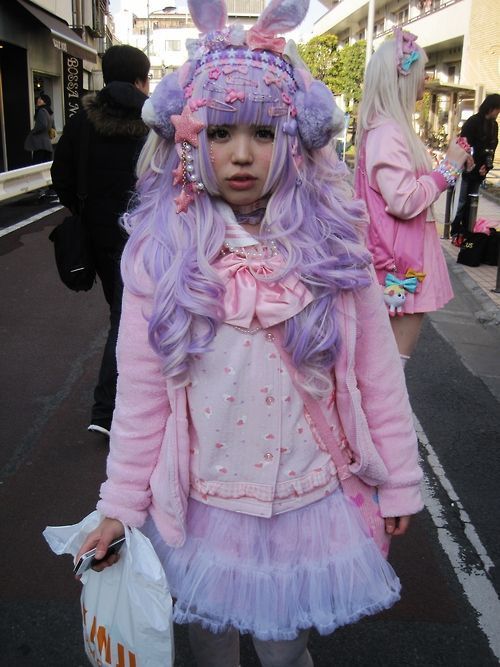
Decora that started in the late 90’s, consists of lots of accessories such as hair clips, toys and bracelets usually from the dollar store,claires,toys or 6% doki doki. Used to be called sensational kawaii in 1995 with the creation of the brand 6% Doki doki. Decora has no rules like lolita fashion,you just mix and match, accessorize and put on a bunch of cute hairclips. Fairy kei (Fairy decora) came from decora but with more cool pastel colors,toned downed, with vintage american 80’s pastel toys aesthetic. One most recognized Fairy kei brand is Spank! The brand has recently come back.

Lolita is a style that started in the 80’s and gets inspiration from the Rococo period. A puffy skirt or frilly outfit doesn’t make it lolita. It has to follow a certain criteria, such as knee length skirt, shoulders covered, modesty, blouse under the dress, petticoat A-line or bell shape, mary jane style shoes, and socks. There are many sub styles in lolita, from country, sweet, vintage, classic, goth, etc. Lolitas also have large online communities all over the world, so makes it easier to find answers to any questions you might have. Such as, can guys wear lolita? Yes! there’s even a male equivalent called ouji. There’s even documentaries you can watch to dive deeper into the fashion, I recommend Sugar coated it was filmed here in California. There are also lolita shops in San Francisco, Paris, and Shanghai. The shops are called Angelic pretty and baby the stars shine bright, the biggest brand names in the lolita community.

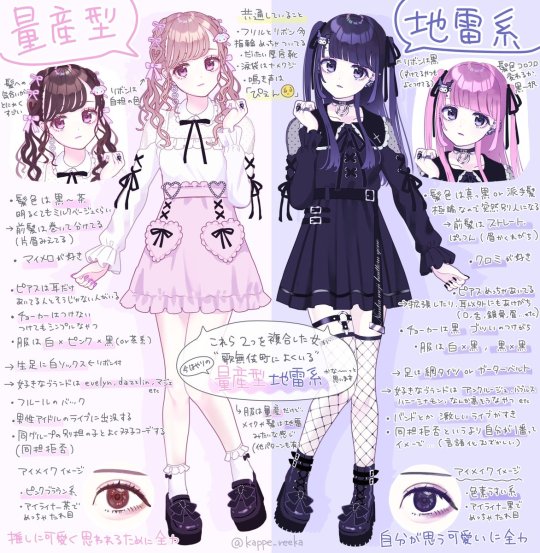
Ryousangata (量産型ヲタク) is one of the newest fashion trends in japan. My first look into the fashion was when I went to Shibuya 109 in Tokyo in 2019 and saw store staff wear this fashion. There aren't many english resources about this fashion yet, but my friends in Japan have explained that they like this. Ryousangata kanji literally translates into mass-produced. The style looks uniform, consists of mostly muted colors mostly black,white, pink, checkered, grey or blue. It has a bit of a gothic tone. Lot’s of japanese brands are selling this style right now due to popularity, such as Ank Rouge, Mar*s, Swan kiss, Evelyn and Dear my Love. The fashion is heavily connected to Otaku (Nerds/Geeks) Culture, since most ryousangata girls are Otakus. They can be otakus over anything idols, anime, kpo, etc. The statement they can make with their fashion is your Otaku but can still look cute/Fashionable. Since in Japan there is still a stigma around Otaku(Nerds) culture, because people have bad stereotypes about them. The word Otaku itself is an insult in Japan, and people don't call themselves that. There are also people who are not Otaku who wear fashion too.
Fashion Guides
https://decora-guide.livejournal.com/
https://fairy-tips.tumblr.com/faq
https://lolita-handbook.livejournal.com/
More Harajuku history
https://www.youtube.com/watch?v=8lyM2Pal1ig&t=308s
https://www.youtube.com/watch?v=rpDCe1Kn3Ds
More Styles
https://yattatachi.com/street-styles-japan
lolita Documentary
https://www.youtube.com/watch?v=W0QSyv8tEgg
https://www.youtube.com/watch?v=wV5FAkyAg_M
Lolita Satire Documentry (Comedy, not serious)
https://www.youtube.com/watch?v=HOeh_O2vi48
31 notes
·
View notes
Photo

MAKING THE MYTH
by Réginald-Jérôme de Mans
Why make a myth? I had that question reading David Dowsey’s Making the Cut, a history of the Australian tailoring firm John Cutler. By coincidence, I’d also finally got round to reading Roland Barthes’ Mythologies, his exploration of myth-making in the modern world, where pro wrestling is our morality play, the steak frites is a sort of French Eucharist, and soap flakes promise absolution to our flatware.
It is blessedly easy to mythologize bespoke tailoring: its vocabulary is arcane and ancient, its true practitioners rare and its initiates often exult in being part of the elect – men (generally) who have not only cash, but the time and the unnatural will to have sought out a legendarily disappearing craft. Tailors now hold themselves out to be – or are held out to be by credulous bards in the media –not only that modern Jedi, actual craftsmen, but practitioners of a sort of wizardry, who lay hands on cloth and thread to create garments that transform the wearer – supposedly slimming the fat, straightening the stooped – into the icon he dreams of being. And the price of that magic is also of another world.
In fact, it was the price of one Cutler garment that caused whatever global notoriety he enjoys, and which was the likely trigger for Making the Cut: in 2013, Meg Lukens Noonan came out with The Coat Route, an examination of all of the materials and crafts that went into the creation of a $50,000 custom coat Cutler made out of a length of vintage Dormeuil vicuña for a customer who had given him carte blanche. Noonan visited vicuña conservators in Peru, met with Cutler’s horn button suppliers and the smith who made the gold chain inside the coat, and interviewed Stefano Ricci, who supplied a length of his trademark garish silk for its lining, as well as, of course, Cutler in Sydney and his Canadian customer.
Noonan found that nearly all of her interviewees were endangered species (now humanely herded and sheared instead of killed for their wool, the vicuñas are an adorable exception). For seeking them out, customers of bespoke clothing can pride themselves on being connoisseurs, not least the coat’s owner, who I believe has now ordered a second one.
As it happens, Dowsey, the author of Making the Cut, first met Cutler (one of a long series of tailors of that name) on a Ricci-sponsored junket in Italy. Like its subject’s custom clothing, Making the Cut itself has been hard to obtain, exquisitely packaged and prohibitively priced: various special editions came with bottles of Scotch or lengths of vicuña cloth, all reminders of Cutler’s creating the most expensive coat known to popular imagination.
Making your vanity book so rare and expensive it itself is a luxury item seems a strange way to make a myth, to get the word out about your subject. Certain of the Savile Row tailors Making the Cut explicitly references sell their books on their websites and through online booksellers, and use their publication to do tie-in articles and pictorials in magazines like The Rake and Vanity Fair. Making the Cut definitely draws on those dutiful and dry tailors’ histories for inspiration. It repeats their narrative arc: heroic founder, struggle of heirs against unforeseen challenges, and eventual restoration to a secure footing, recounting the Cutler dynasty’s immigration to Australia and gradual development into a prestigious bespoke tailoring business making for the rather colorful Australian great and good – athletes, hotheaded sheep farmers, politicians and businessmen. Dowsey compares the Cutlers’ rise to that of another traditional bespoke craftsman who had emigrated to Australia, John Lobb, who became successful making boots during the gold rush there before returning to London and opening what is undoubtedly the most famous custom shoemaker in the world. The Lobb family’s own history, The Last Shall be First, came out 45 years ago. Making the Cut seems intended to set Cutler among these otherwise British legends of traditional craft.
But why? The reasons the British tailors and bootmakers whose stories set the pattern for Making the Cut came out with books were apparent: age-old houses, many under different, corporate ownership now, seeking to spread their reputations in an age of new accessibility. Their continuity was assured. In contrast, Making the Cut itself notes that the current John Cutler’s children are not likely to enter the business, and that most of the cutters and coatmakers instrumental to custom clothing have gradually left. So this book, for all its painstaking immigration details, vivid recitation of John Cutler’s romantic histories and dozens of pages of press cuttings and customer pictorials, attempts to create a myth without much commercial justification – the justification for so much of today’s myths. Cutler the man, Cutler the business may soon be names out of time.
Does recognizing the components of a modern myth collapse it? Both The Coat Route and Making the Cut approvingly inform the reader that no less an authority than Forbes magazine proclaimed that Cutler was one of the best tailors in the world. The reader must be expected to imagine that Steve Forbes (or Teve Torbes) himself announced this epiphany. Unfortunately, the article in question is a clickbait listicle from the Forbes website, which is better known for unhinged and unsupported op-eds that would make The Wall Street Journal opinion page blush. Its support for why Cutler is the best appears to be that a customer can also order a custom overcoat and a pair of shoes there. But any tailor who makes suits cam make an overcoat. As for being able to order shoes, if variety meant quality then the Chinese place near my house that also sells sushi and Thai food must be the best restaurant in the world. In any case, Cutler’s shoe offer was a special order service with the late Italian shoemaker Stefano Bemer, not a true bespoke service with a custom maker creating a wooden last for each customer and welting shoes by hand. For all I know, Cutler may be one of the best tailors in the world, but the Forbes list isn’t why. I have no personal experience with Cutler or any Australian tailors, but my friends and I have worn out the carpets at the good tailors of Paris, where the Forbes article recommends solely the bespoke section at the department store Galeries Lafayette, which is a bath-salts level of unreliable, crazy and stupid. None of us had ever heard anything memorable about this service, although my 2003 Paris sur mesure does mention, as an alternative to good full bespoke and cheaper made-to-measure tailors, a demi-mesure service at Galeries Lafayette, where customers could select cloth for a factory special order made to stock sizes, with the possibility of some alterations after the fact. But in no way could that compare with having someone who knows what he or she is doing measure, create a pattern for, fit and otherwise hand-tailor you.
With Making the Cut, Cutler no longer needs to found its myth on Forbes’ shoddy support. It has all the architecture (long history and heritage, glossy photos and testimonials and mildly entertaining anecdotes) for today’s mythmaking, craft trades edition. Even if it’s a final snapshot for a family album.
Quality content, like quality clothing, ages well. This post first appeared on the No Man blog in 2018.
4 notes
·
View notes
Text
Anonymous asked: I’m taking a gap year before I go up to Cambridge to study History and I am a big fan of your blog. I am in awe of your posts and your intellectual musings that really makes me wonder if I’m smart enough to succeed in Cambridge. I want to know what book shops did you spend time in when you were a student. Do you still find time to go to the English book shops in Paris now that you are busy in the real world of having a demanding career? Can you recommend some?
Congratulations on getting into Cambridge to read History. That’s an achievement in itself. I understand the History department has consistently rated as one of the best in the world in the global university rankings so it’s an achievement. Perhaps in time you can become the next Tom Holland or William Dalrymple?!
I spent many spare hours browsing through second hand book shops as a student (gosh! It feels like a life time ago now!). When I wasn’t drowning in books in my college library trying to stave off an essay crisis I was seeking sanctuary in mostly second hand book shops dotted around the city.

I obviously wouldn’t count the Cambridge University Press bookstore a second hand book store but I did go in often because it had frequent second hand book sales and it was always exciting what new specialist books were coming off the press written by our professors (buy their tomes for brownie points obviously and use it as a coffee coaster). It’s claimed that the CUP book shop is the oldest in Britain but I’m confused. I know Cambridge University Press is the oldest publishing house in the world but where the bookshop stands it used to be called Bowes & Bowes which claimed to be the oldest book shop since 1581. They got bought out at some stage and somehow CUP took over the shop. So make what you will of it.
Heffers - opposite Trinity College - was another book shop I would go to a lot. Again, not a second hand book shop but they carried the most wide ranging of books of all interests and served as an alternative to Waterstones, the big high street book store. I thought I was supporting a local book shop (however big it was in Cambridge) when I found out years later that it was actually owned by Blackwell’s (the same giant bookseller Blackwell’s in Oxford). Hmmm.
In my time, the Cambridge Market Place on certain days had second hand book stalls set up alongside all the colourful fruit and vegetable stalls. A browse through those stalls was never a wasted exercise. I even met one of my boyfriends whilst browsing there - we both fought over the same book we spied from afar (he put his fingers on it first but I was quicker to snatch it away before he put his palm down). I felt bad for him so I let him buy me tea at the Copper Kettle, opposite King’s College.
During my time in Cambridge I know some friends would go to the Sarah Keys the Haunted Bookshop in St. Edward’s Passage (so named because of the two ghosts which are rumoured to reside on its premises.) It was mostly filled with vintage children stories and had a tiny couple of tables for coffee. I found it claustrophobic and the coffee was ghastly. I avoided it because it really didn’t have any good books at all. Students went because it’s the closest it got them to some Brideshead Revisited fantasy of musty smelling books.

My most frequent haunt was actually also in St. Edward’s Passage was G. David. This independent bookshop sells antique, secondhand, remaindered books, maps and prints dating back to the late 1800s. For over three centuries the G. David bookshop has been run by the founder's family. I spent much of my student money in there. To this day whenever I go back to Cambridge to see friends (some are now teaching Dons in the university or work in the so-called high-tech ‘Silicon Fen’ community) I always make a point to go there for a quick browse. I always buy something there, usually a gift for someone but always some gem for my growing book collection. The shop is small but the service is intimate and homely. It’s a paradise for Shakespeare, Classics, and History lovers.

Later when I went over to study at Oxford, I would inevitably end up going into the legendary Blackwell’s on Broad Street. You needed to wear a comfy pair of sneakers if you ever venture into the Norris Room as it’s the largest single room selling books according to the world in the Guinness Book of Records. With about 10,000 square feet and three miles of shelving to browse through, don’t ever say they don’t have the book you’re looking for.
Another bookshop I would go to a lot was Last Bookshop which was tucked away in the Jericho area of Oxford. They always had these ‘two books for 5 pound’ deals which was great if your budget was tight (as it always is for impoverished students). The coffee area was cute and the coffee was bearable.
Then there was St. Philip’s Books on St. Aldates, opposite Christ Church Gardens. They specialised in rare and secondhand books in the the broad humanities from theology, history, literature, philosophy, art, classics and antiquarian books. If you were into C.S. Lewis and J.R.R. Tolkein or any kind of Christian theology and patristics then this was the place to go to.
In London where I used to live I tried to be as local as possible given how big London is and also a preference for independent ones (be they second hand or antiquarian). There are a mecca of bookshops and second hand book stores scattered around London and so I’m always pleasantly thrilled when I stumble upon a new discovery by accident or word of mouth.

My absolute favourite that I used to frequent a lot - and I still do when I go back to London - is John Sandoe Books in Chelsea. It’s tucked away in a quiet side street around the corner of Sloane Square. Going inside feels like rummaging through some fusty old Professor’s home with low ceilings. It’s actually made of up three small 18th Century Regency houses somehow tacked on together so the creaky floor boards seem uneven as you wander around. Although it’s a general independent bookshop, the vast majority of its books range from history, classics, poetry, and biographies. It has an enviable Everyman collection to die for and you can also get lucky buying first editions. My grandfather used to know John Sandoe, who started the business 60 years ago after he left a career in the City to try his hand at bookselling much to the disapproval of his father. Sandoe sold the business to two ex-colleagues and a loyal customer in 1989 and he died in 2007 after enjoying a well earned retirement in Dorset apparently.
My grandfather was especially fearful of Sandoe’s colleague the formidable Felicité Gwynn who worked there for over 25 years (she died in 1984). Not only was she an expert on all things equestrian but she had a a passion for literature that would put an Oxford Don to shame. However she had little patience for tiresome customers and it was said she sometimes threw books at them. To me it’s the perfect afternoon escape especially on a rainy day. Hands down I think of it as the best bookshop in the world since I’ve known it from my earliest childhood. I cherish the memory of coming home to England for brief sojourns from living overseas and I was super excited to take a trip to Sandoe. Time there fed my love for reading and learning. If you ever go there you will find that the staff are friendly and knowledgable. They will never patronise the customer…or throw books at you.
Hurlingham Books, an independent bookshop on the Fulham High Street is another favourite of mine whenever I am seeing friends, cousins, or siblings. It’s a short walk on the Fulham road from Putney Bridge tube station. The shop is carpeted with books from the floor to the ceiling. It’s like a narrow maze of bookshelves everywhere. There is always something to buy there on any topic under the sun. It’s not the most beautiful bookshop aesthetically speaking but it’s an unpretentious pleasure to browse through its many wall to wall books.

In central London my most frequent haunt is Hatchards off Picadilly Circus. It was founded in 1797 and still retains a very English identity. Sadly it’s been bought out by the high street giant, Waterstones, but they wisely left it intact. It stocks all the latest releases and has many author driven events. For me it’s been a post-lunch ritual to go there as it is just around the corner from the gentlemen’s clubs I am a member of (nearly all now elect women as members). I sometimes invite friends for lunch or frankly to impress a foreign business client at the club. I then wander off around the corner to browse at Hatchard’s to work off the lunch. But mostly this ritual of lunch at the club and then a browse at Hatchards I associate with my father and my siblings, even to this day. We all lead busy lives and yet we come together over lunch and then jaunt over for a bit of book browsing. What’s perfect is that Fortnum & Mason is almost next door and so it’s a perfect place to pop in to buy special blended Fortnum’s tea and jams to take back to Paris and give out as gifts to friends.
I would make a special mention to Maggs Bros bookshop which primarily deals in first editions, antiquarian, and rare books and is one of the oldest in the world. This old bookshop has now two shops, one in Bedford Square and their original shop in Curzon street in Mayfair. They have a fine collection of over 20,000 books going back to the 15th Century in many specialised fields. The buy and sell rare books and also let their customers know about first editions. So in the past they’ve had such precious gems as first 1922 editions of James Joyce’s Ulysses as well as copies of Shakespeare’s four 17th Century folios and even pocket diaries of Virginia Woolf. My parents are avid book collectors and they both frequent this shop to pick up first editions on anything from literature and architecture to military history and travel exploration. I must admit it’s a delightful place to browse for a special gift as one can never go wrong with giving a book as a gift.

When I was working in the City of London I couldn’t wait to get away from the pressures of work. During my lunch break or after work I would wander over to Hanbury street in Shoreditch to visit a very cool and atmospheric bookshop called Libreria. The mirrored ceiling and intensely yellow bookshelves and comfy seats are meant to disconnect you to the world outside. No phones are allowed. The books are arranged by theme so it’s a magical mystery tour of sorts browsing books and coming across books you might never have considered in the first place.
I do go out of my way to drop in on the Bloomsbury area for a browse is the London Review bookshop. The bookshop is on Bury street. Bloomsbury is known for its literary connections to Virginia Woolf, E M Forster and others literary icons. The shop itself is owned by the purveyor of long-form critical writing that is the London Review of Books. There’s also an adjoining tea and cake shop to put your feet up after a good browse through its extensive literature and humanities collection. There are other quaint bookshops in Bloomsbury area and they are well worth exploring too such as Jarndyce Antiquarian Booksellers outside the British Museum. They specialise in 18th and 19th century English literature and history and you can be sure to find some amazing editions of Dickens’ work here alongside Hazlitt’s writings.
Recently I discovered another gem of a secondhand bookshop near to St. Pancras station called Judd Books. St. Pancras is where I come back and forth on the Eurostar between Paris and London. I hate crowds and I hate waiting. So if I have time to kill I take my small carry on luggage and wheel myself across Euston road down a side street called Marchmont street. It’s nothing fancy but a very functional bookshop selling tons of secondhand books that are almost brand new, mostly general fiction. Books line the walls from floor to ceiling so you may even need a ladder to reach the very top shelves.
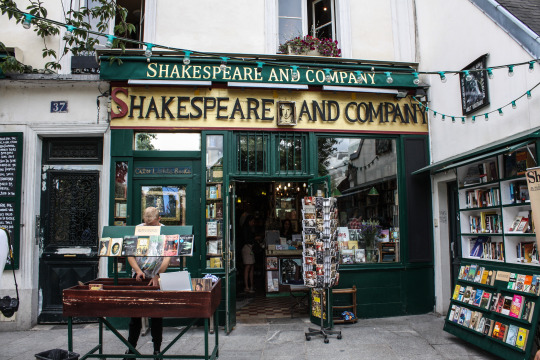
In Paris where I now live I do go out of my way to support local bookshops even if the cost of an English language book is more expensive than if you bought it from the UK - this is because of added French taxes on imports. Still, it’s a small price to pay. Everyone will say the premier English bookshop in Paris is Shakespeare and Company. It is undoubtedly the most famous English bookstore in Paris. Perhaps even one of the most famous bookstores in Paris period. When it re-opened in 1951, it became a sort of hub for ex-pats living in France. It was inspired by the original Shakespeare and Company store by Sylvia Beach in the 1920s and 1930s where writers such as Joyce, Hemingway, Fitzgerald, Eliot and Pound would gather. George Whitman took over and he paid homage to her amazing example.
The shop today continues to attract numerous anglophone readers, writers and tourists every day. And that’s why I try and avoid it if I can. It’s a wonderful bookshop and tons of books to get your teeth into. But it’s simply over-crowded by tourists who are just taking selfies. Moreover the shop is manned by sincere but earnest young American literature graduates who want to have some of that Hemingway or Fitzgerald magic dust sprinkled upon them by association whilst writing their own Great American Novel Written in Paris. I find it grating that some of them feel they have to give you a full blown semiotic laden book review on a book you’ve asked if they have in stock or not. But the bookshop does put on great open events where many famous authors drop in and I know it does support aspiring amateur writers.
There are other English language bookshops worth visiting in the Latin Quarter, the student area and where the Sorbonne is. The Abbey Bookshop, Berkley Books, and San Francisco Book Company are similar in that they are decent places to spend a lazy afternoon browsing English books of all kinds. Of the three the Abbey is better. It’s mostly dog eared second hand books What I love is the presentation of books. Books seem to cover every single inch of this tiny store. You have to be contortionist to get around the tiny shop. There are books piled high in every nook and cranny of the place and one misstep could bring tonnes of books down upon you. I admire the shop for trying to cram so many titles into one tiny space. I generally avoid the Latin Quarter because it is saturated with tourists and it’s just over crowded. But because it’s full of university students there are many French language second hand book stores and antiquarian and rare bookshops which are definitely worth a browse.
The Red Wheelbarrow, a tiny bookshop in the Marais part of Paris is well worth a visit.
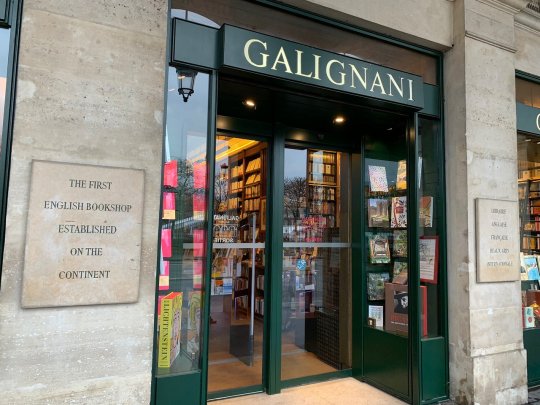
The bookshop I go to for English language books is Librairie Galignani on rue de Rivoli - opposite the iconic Tuileries Garden. The bookshop at this site has been run by the Galignani family since the beginning of the 19th century and it’s certainly the most grand of the English language bookshops in Paris. Indeed, the Galginani family has been in business since 1520 as publishers but they also boldly claim to be the first English bookshop established on the continent. On their website Galignani does boast an impressive history: “The Galignanis were among the first to use the recently invented printing press in order to distribute their books to a larger audience. Beginning in 1520, Simone Galignani published in Venice a Latin grammar (the oldest “Galignani” known). However, their greatest success was the Geografia by PTOLEMAUS published in 1597, an incredible bestseller in both the 16th and 17th centuries. Not surprising, the shop has moved locations several times in four centuries, and only as recently as 1856 has been on the present shop on the rue de Rivoli. It is still run by direct descendants of the original family.
It is an international bookstore, so there are of course massive amounts of titles in French, as well as other languages, mainly English. It has a wonderful fine arts section. It stocks all the latest releases in fiction and non-fiction for both English and French titles and the prices are the same as elsewhere. Be warned though, if you want to soak up the atmosphere of an ancient bookshop then you will be disappointed. It’s luxuriously pristine and smells of pine. The shop is large and deep, with floor-to-ceiling dark wooden shelves and upper levels that can be reached by a swish staircase. It oozes sophistication. It’s a good place to bump into handsome young sophisticated French men who are worldly and charming without being intellectually tortured or pretentious as the ones you might come across in the Latin Quarter. It’s how I met one of my French boyfriends at the time.

Down the rue de Rivoli I should mention WH Smith, the well known British high street retail book shop. It’s the largest English-language bookstore in France. The books on sale are the same as you would find in the UK. But what makes it worth a visit is the rows of magazines you might want from design magazines all the way to Harvard Business Review and the Economist. The real jewel is upstairs where they have a great English children’s book section for all ages. You’ll find French parents picking with their sprogs picking up books They also stock hard to find British (and even American) foods from Heinz baked beans to candy bars. But one of the main reasons I go there is for the scones (served with clotted cream and jam) and decent tea served in the cafe that’s tucked away upstairs. It’s a nice place to take Anglophile French friends.
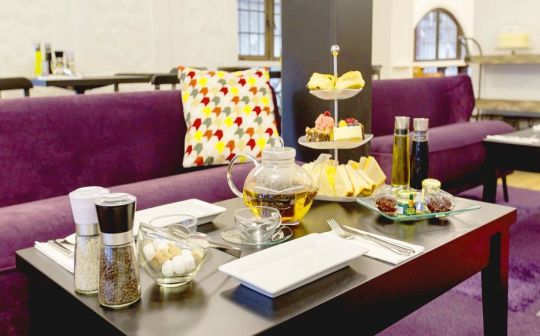
Congratulations again on getting into Cambridge to read History. You got in on merit and hard work so you’re fully deserving of your place. Make the most of it. It’s good that you’re taking a year out before you go up to study. I think many universities will only just be picking up the pieces from the awful mess the pandemic will have left them with.
Thanks for your question.
#ask#question#bookshops#books#reading#cambridge#oxford#london#parisfrance#personal#bookstores#bookshop#heffers#sandoe#john sandoe#WHSmith#galignani#maggs bros#g.david#shakespeare and company#red wheelbarrow#hatchards#paris#france
70 notes
·
View notes
Text
Tag game: A LIST OF STUFF
I was tagged by the ever creative & hilarious @tortoisesshells! Thank you!
Nicknames: Aside from the baby one my dad still embarassing uses and a high school one that re-emerges once a year with our annual get-together, surprisingly none. Or actually, my sisters and their kids calls me Gradi (French-sounding, GRA- like “grass”-DEE) because that’s how my name came out of my first niece’s toddler mouth a dozen+ years ago, and everybody thought it was hilarious and adopted it. No Matante title for me!
Zodiac sign: Gemini / Cancer hybrid. Never checked which one it was on my birthyear because that’s how much stock my STEM brain puts in astrology.
Height: 5′7″
Hogwarts House: I’ve gotten both Ravenclaw and Slytherin, which totally tracks and is apparently pretty on par for INTJs.
Last thing I googled: The right spelling of Slytherin. Hey, it’s been a while.
Before that, “Légende de la Corriveau”, because my son learned about it in school, and my partner and I were arguing about how many husbands she really had, and whether she was hanged first or died in the infamous cage. Confused? Read the original Québec witch story Here, brought to you by the Treaty of Paris and the British takeover of New France.
Song stuck in my head: Toxic, Britney Spears. It’s been everywhere, this week.
Fav musicians: Sounds blasphemous but... I’m not a big music person? So... whatever’s upbeat and fun and singable on my commute, like... ABBA? Cheesy 90s bands? Barenaked Ladies? Whatever Princess Poppy the Pop Troll is into. Just nothing country or too experimental jazzy.
Following: 52. Hmm. I need to branch out. Any fun blog recs?
Followers: 70. Huh. I’m really surprised that number is larger than the previous. You lovely people are quiet; I thought there was only a dozen of you :)
Do you get asks: Rarely, and pretty much only when I ask for prompts.
Amount of sleep: 6-7hr most nights, 8 on the weekend, and they are FINALLY, after almost a decade of young kids with terrible sleep patterns, mostly uninterrupted. So 6hr straight totally beats 8hr in bits&pieces.
Lucky number: I’ll pick 21 if the options go that high. If not, probably 3.
What are you wearing: Fridays are Blue Checkered Shirt Day at work, and it’s a Team Tradition that I will never break for as long as I work here (and will probably institute wherever I work next). So flannel edition because Winter and jeans, because Friday.
Dream jobs: 1920s egyptologist, forensic anthropologist, The Thirsty Traveler, retired grandma who plays golf, hikes, writes, bakes and spends the worst of winter someplace warmer.
Dream trip: A few weeks with loved ones in a comfortable rented house some place near the sea, old historical cities and natural sites, with a rental car to drive around and visit at our own pace during the day, and nearby shops full of local produce, coffee, drinks, cheese and bread for relaxed evenings talking away on the starlit patio with a home-cooked meal and plenty of good wine.
Instruments you play: Does -badly- teaching myself rudimentary guitar in HS and going through Simply Piano last year count? ... yeah, didn’t think so. So, none. I’m more a Sports & Books type.
Languages you speak: Fluent French (first) and English (since childhood), above tourist level Spanish and German, but for no rational reason because they are the least similar languages ever, the two get mixed up like crazy when I speak either (both must be stored in the “Languages I Suck At” portion of my brain). And I never spoke as good Spanish as when I tried to speak Portuguese, which I can read decently enough, but understand when spoken? Not at all.
Fav song: Again with the music... ugh. I don’t know. Creep by Radiohead? Anything but Helter Skelter from The Beatles? Let’s Groove from Earth, Wind and Fire? Some Bryan Adams power ballad? Hopefully also something from the last 20 years...
Random fact: My dad got the inspiration for my first name from a guy he met at a disco nightclub... who he later found out to be a male exotic dancer. Yup, I was apparently named after a Magic Mike disco dude.
My mom found out at the same time I did. She was considerably less amused than I was.
Cats or dogs: Cats, 200%. Black ones all the better, although I relented and we adopted one of our foster babies, a tabby. He’s the devil but he’s also super sweet and cuddly. We named him Fofos, which is Portuguese for sweet / cute/ cuddly / fluffy (it is also wrongly plural but hey, it was always plural on the boxes of buns and cakes we bought in Portugal, and I already mentionned how abysmal my Portuguese is).
Aesthetic: Puzzles, books and movies in a cozy cabin with a fireplace in a snowy Laurentian forest; late summer nights at the ballpark, days by the pool and vegetable patch, the smell of BBQ in the air; flour-dusted vintage aprons, new recipes, planning meals & drink pairings; periodic tables, Erlenmeyer flasks, just being a nerd.
Tagging anyone interested!
5 notes
·
View notes
Text
Adding Linens to Your Tablescape - How to Style a Tablescape Like a Professional - 9th in this series
Vintage linens are some of my favorite finds in the last few years and they were sure a hit at the fundraiser!
Did you know that linen, both vintage and new, are becoming all the rage again? Yup.
Why? Because linen is a sustainable product that is easy to care for. They can be used repeatedly, and it is a sustainable product that contributes to the overall health of our environment.
Let’s look at just a few facts about linen in general
Linen is one of the most biodegradable and stylish fabrics known in history. It is strong, naturally moth resistant, and made from natural plant fibers.
One of my favorite linen manufactures who live and breathe organic sustainable products is Libeco Belgian Linen Company. They are one of the leaders in this global industry and are certified as a Global Organic Textile Standard (GOTS).
Linen comes from flax seed which is a very sustainable fiber
It requires no irrigation: the flax plant loves the Belgian climate (wet and moderate). The natural circumstances are ideal for flax cultivation, so the plant doesn’t need extra irrigation.
No GMO's or crop protectors: organic products are made from flax that is cultivated organically, without the use of GMOs, crop protectors or fertilizers.
There is no waste: all parts of the flax plant can be used as a resource for other products.
To learn more about linens and how to care for them, follow this link to my blog, Oh those DAUNTING Linens!
Now, let’s look at the linen fabrics I used for my tablescape design
For me, linens are everything on a tablescape. Using linen give a sense of luxury to an ordinary table design. If you want to bring your design to the next level, use lovely linens and layer them to give more texture and pattern to your table.
I used four main table linens to add layers and patterns.
I first chose a simple round table skirt to place over the table base. It puddled to the floor so that the legs would not show and to add elegance of the table.
Note: If you have a tablecloth that goes to the floor, it is considered formal. The shorter the tablecloth the less formal.
Next, I chose a beautiful square white linen tablecloth for my second layer. This gorgeous tablecloth went to the floor on four sides of the tablescape. The tablecloth had a lovely embroidered detail all around the edging of the fabric making for a more structured look. It really helped to make that specific layer stand out against the white tablecloth below it.
I then added a luxurious light gray French Jacquard tablecloth on top of the white linen. This added a pop of color I was looking for. I had a good amount of gray in my centerpiece and this tablecloth was perfect for adding and coordinating the colors elsewhere in the table design.
And finally, I curated a beautiful table runner that had all the colors I was looking to add to my tablescape. The runner was beautifully embroidered with flowers of blues, greens and grays that cascaded down the length of the fabric. It added to the overall texture and color of my design and added a romantic garden feel.
I also added a few more linens such as vintage and new napkins as shown here.
Monogrammed napkins are always a good idea and are now a big design trend as well!
I had these beautiful linen napkins monogrammed in an ice blue color to give my design just a little bit more color and some interest. The “H” represents our family name, Hickey. This is definitely a napkin that is special enough to hand down as a family heirloom.
I curated the monogram design placing a bee just above the “H”. This was done so that the napkin can be simular to the other vintage bee linens I was adding to the design. I wanted the entire tablescape to have a cohesive look and feel to it
To learn more about what the Bee symbol represents in the French culture, click on this link. This link is to my other blog where I give more information about the special symbolism of the bee and how to create a color pallet for your table.
I absolutely adore these vintage cocktail napkins. I found them at an estate sale a few years ago in Connecticut. They were originally from a little store in Paris called Majolique that no longer exists. The embroidery is gold and silver thread and is very delicately crafted. They were never used and are in perfect condition. It was a lucky find.
""The details are not the details. They make the design."" -- CHARLES EAMES
“The thing is…linens create an ambiance that sets the tone of your dining experience. Using a combination of vintage and new linens give your tablescape character and warmth. They bring to a design, in my opinion, a softness and romance that can’t be found otherwise.”
I also added another gray linen napkin to the inside of the basket just in case my other tea towel moved. I wanted to be sure I secured the stems of the flowers the best I could.
Here is a quick video of my finished tablescape.
“Mon Jardin à la Française” or “My French Garden”
As with everything I post on my blogs, please feel free to comment or if you have any questions, please email me through my contact page. I welcome it anytime!
Design with your heart™️
Happy entertaining my friends!
Mary
"May your home be a place where friends meet, family gathers, and love grows. " -- Anonymous
#entertaining#how to hang a chandelier#how to choose a chandelier#what size chandelier do I need#how to pick out a chandelier#chandelier#chandelier size#which chandelier size do I need#chandeliers over the table#size of chandelier#chandelier hanging#chandelier diy#diy chandelier#how to hang a light fixture#how to pick out a light fixture#Kitchen remodeling#kitchen upgrade#ways to save money on kitchen redesign#how to host a sitdown dinner#hosting a dinner#holiday dinner#how to set a table#how to set a dinner table#biscuits#homemade biscuit#biscuits for the holiday#savery biscuits#old fashion biscuits#biscuit recipe#old fashion biscuit recipe
1 note
·
View note
Text
BLOG POST: 4 Inspiring Fashion Exhibition

This Week's Topic?
At the office, we really enjoy visiting fashion exhibitions as it allows us to keep up to date with the creative world and learn more about some of the most famous and influential designers. It allows us to understand their impacts on how fashion has been shaped to what it is today. We are able to see garments up close to understand how they have been made. As well as going to see exhibitions of other designers who we love or are inspired by, we also visit exhibitions about other artists too who express themselves with different media.
Read More --> https://mellaris.com/…/edit…/4-inspiring-fashion-exhibitions
Alexander McQueen: Savage Beauty
One of my all-time favourite designers is Alexander McQueen and in 2015 I was able to go and see the Savage Beauty exhibition at the V&A museum in London. Savage Beauty exhibition celebrates the remarkable talent of "one of the most innovative designers of recent times". Alexander McQueen: Savage Beauty was the first and largest exhibition of McQueen's work to be presented in Europe.
The exhibition was an amazing chance to be able to see some of his most famous work from over the years. You were able to get quite close to some of the garment, whether they were behind glass or not. Whilst I was there, I also decided to buy a book about McQueen and the exhibition so that I would be able to study it in the future and remember the exhibition as the years go by. I have to say that the room I remember the most was one of the last rooms because it had some of the outfits from his very last collection (Plato’s Atlantis) in 2010. They also had a video of the final catwalk blown up on a screen behind the mannequins which was just incredible to actually have the chance to be able to see. I also loved how they created an installation which was a reflection of McQueen’s 2001 collection ‘VOSS.’
Another great thing is the fact that at the flagship McQueen store in London, today, you are able to see some of the pieces that were on display at the exhibition but even closer. They also have diagrams, notes, booklets, textile samples and much more on display from a combination of McQueen’s work as well as work done by the current creative director of Alexander McQueen, Sarah Burton. I feel like this was such a good opportunity to allow people to see all the intricate detailing and time that had gone into making these iconic garments. The fact that they still had all the casing/boxes from the exhibition and the popularity of it makes me think that maybe sometime in the future they might put the exhibition on again since it was so amazing. During the last few weeks of the exhibition, the V&A was open 24 hours a day in order to meet the demand of the people that wanted to come and visit.

Balenciaga: Shaping Fashion
Another exhibition that some of us at the office have had the chance of going to is Balenciaga: Shaping Fashion at the V&A last year. The exhibition examined the work of Spanish couturier Cristóbal Balenciaga, including over 100 pieces crafted by 'the master of couture'. The exhibition was made up of two floors where on the ground floor you were able to see a selection of his work from over the years and then on the second floor you were then able to see another collection of work from designers that had been inspired by Balenciaga. What I found most interesting about the second floor was the fact that you’re able to see just how much of an impact he’s had and how the work he’s done in the past still continues to inspire people today.
I really like the ground floor because of the amount of information and work from archives that had been provided for the exhibition, I felt that I was really able to learn a lot of things about him and his way of working. One of my favourite pieces that were in the exhibition was the pink silk taffeta dress that was spinning around so that you were able to get a complete 360 view of the dress as well as seeing the x-ray of the dress behind it too. I thought to have the x-ray accompanying the dress itself was cool because you got to see the insides of the dress from a different perspective.

Inside the Christian Dior: Designer of Dreams exhibition
One of the most talked about exhibitions currently being held at the V&A is titled “Christian Dior: Designer of Dreams,” which I have wanted to visit ever since I first heard about a Dior exhibition that was happening in Paris a while ago. I knew that the exhibition would be extravagant and amazing and from the photos and videos that I’ve seen from friends, I can definitely say that I was right.
“This exhibition presents over 200 rare Haute Couture garments drawn from the V&A's couture collection and the extensive Dior Archives alongside accessories, fashion photography, film, vintage perfume, original make-up, illustrations, magazines, and Christian Dior’s personal possessions.”
Even though the exhibition is mostly sold out due to its popularity, through research I have found that there are a few days in May where they still have tickets on sale and sometimes if you turn up first thing in the morning the museum sometimes have a few extra tickets for the day.

Mary Quant
"The whole point of fashion is to make fashionable clothes available to everyone." Mary Quant
An exhibition that I would like to visit in the near future is the one that has just opened at the beginning of this Month at the V&A for the designer Mary Quant. She is one of the most famous designers from the 60s and is often associated with the invention of the miniskirt. The exhibition showcases the discovery of how Mary Quant launched a fashion revolution on the British high street, displaying over 200 garments and accessories and even includes unseen pieces from the designer's personal archive.
One of the reasons why I would like to have the chance to visit the exhibition is because I had really enjoyed learning about her and her work in my first year of University. I would love the chance to be able to see some of the designs in person. I would also like to continue to learn more about her way of working and her impacts in fashion. Some of the most striking images associated with Mary Quant’s garments are the ones that are modelled by Twiggy.

At the office, we all really enjoy going to exhibitions as it allows us to keep up to date with the fashion world and learn more about some of the most famous designers and their impacts on how fashion has been shaped to what it is today. We are able to see garments up close to understand how they have been made. As well as going to see exhibitions of other designers who we love or are inspired by, we also visit exhibitions about other artists too who express themselves with different media. Sometimes, their art can even serve as inspiration for textile and fabric idea, for example, Anjelica went to see the exhibition: Monet and Architecture featuring more than seventy-five paintings by Monet. After visiting the exhibition Anjelica came across this beautiful fabric that reminded her of Monet creations.


#fashion#fashiondesigner#fashionexhibition#london#alexandermcqueen#maryquant#christiandior#balenciaga#inspiration#blog#ukfashionblog#blogger#fashionblog#mellaris#mellarisofficial#ukbrand
4 notes
·
View notes